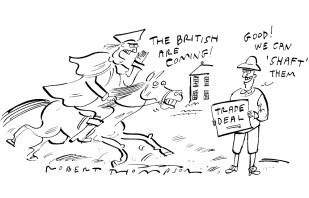
We had been discussing Ukraine, Gaza, Iran, the possibility of a nuclear exchange across the Punjab and other trifling matters. It was decided to change the subject. A youngster was planning to write a piece on lunching and suggested I might know something about that. I did not disagree.
In the old days, lunching was a vital part of the political process. It was a good way of getting to know politicians, so that contacts would ripen into friendships. That said, it was not an efficient method of discussing complex matters. Lunch was forgossip and general political impressions. If detailed rumination was necessary, the place for that was in the minister’s office, equipped with a notebook. The 1980s were particularly fruitful. I lunched my way around the higher ranks of the Tory party with the assistance of Neville and Sonia Blech of the Mijanou restaurant.
‘If that is how they lunch their enemies,’ thought I, ‘how do they treat their friends?’
Sonia’s cooking was excellent, although she never received as many rosettes as she deserved. I especially remember a ravioli aux truffes, which sounds like a dish devised by Anatole, Aunt Dahlia and Uncle Tom’s much coveted chef, from various adventures of Wooster and Jeeves.
Neville organised a superb and reasonably priced wine list. I even remember drinking some Le Pin there. Neville would say that there was only one disadvantage about feeding some grandees. Various cabinet ministers – defence, foreign secretary, Northern Ireland – were obliged to have a detective in tow. That meant a solitary table, and Mijanou was not a large establishment. Moreover, the detective would eat the set menu and drink only water. But it was worth it for the prestige.
That was an era of generous journalists’ expenses. One of my employers required claims to include the name of the guest, and that sometimes necessitated an adjustment. The minister would announce that he was on a regime. His wife was aware that he was lunching with me and he would be interrogated as to what he had consumed. If the replies were unsatisfactory, he would not be allowed any dinner. So for him, a salad and a single glass of champagne.
But within a few hours, I could be dining with his special advisor: young, hungry, thirsty and no constraints on his regime. So the two bills might somehow be juxtaposed.
Not only journalists used lunch in this way. The Irish embassy was notorious for its lunching and its parties. I do not know what proportion of Ireland’s GDP was expended thus, but it must have been significant. I remember once meandering out of Tante Claire after some Irish diplomatic hospitality. We had enjoyed a delicious lunch accompanied by three bottles of wine (but no more, surely?). I was a staunch Unionist, perennially suspicious of Dublin’s schemes. ‘If that is how they lunch their enemies,’ thought I, ‘how do they treat their friends?’

Irish wiles did not always work. My then editor, Perry Wors-thorne, once arrived back from lunch and it had obviously been a good one. His host, one Ted Smyth, as cunning a fellow who ever adorned the London diplomatic circuit, had told Perry that opinion in Northern Ireland was swinging against the IRA, who had lost almost all public support. I expressed scepticism. ‘But you haven’t been over there for ages. Perhaps an early trip is what you need.’ I heartily agreed: any excuse for a visit to the Province. But before it could take place, Lord Justice Gibson was murdered by an IRA car bomb. ‘Now we’ll see who is right,’ declared Perry. ‘Will the local population rise up and hand over the killers?’ Oddly enough, that did not happen.
Long may the va et vient of lunching, diplomacy, politics and, indeed, of friendships continue.







Comments